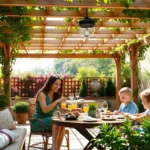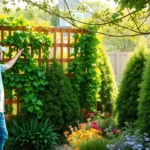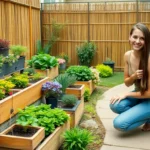A garden fence does more than mark property lines—it’s your opportunity to transform your outdoor space into something truly spectacular. The right color choice can make your garden pop create stunning visual interest and even increase your home’s curb appeal.
We’ve discovered that choosing the perfect fence color isn’t just about personal preference. It’s about understanding how different hues interact with your industry complement your home’s architecture and reflect your unique style. From bold statement colors that demand attention to subtle earth tones that blend seamlessly with nature the possibilities are endless.
Whether you’re working with wood vinyl or metal fencing we’ll guide you through the most inspiring color combinations that’ll make your neighbors stop and stare. Ready to discover how the right fence color can completely revolutionize your garden’s appearance?
Classic White: The Timeless Garden Fence Color Choice
White remains the most popular fence color choice among homeowners for good reason. This versatile color creates an elegant backdrop that enhances any garden design while maintaining broad appeal for property value.
Benefits of White Fencing for Garden Aesthetics
White fencing creates visual continuity with your home’s exterior trim and architectural elements. The color reflects sunlight effectively, making smaller gardens appear more spacious and brighter throughout the day. We find that white fences serve as neutral canvases that allow colorful plantings to take center stage without competing for attention.
Property values increase when white fencing is properly maintained, as this classic choice appeals to the widest range of potential buyers. Clean white surfaces create crisp lines that define garden boundaries while maintaining an open, welcoming feel. Gardens appear more organized and intentional when framed by pristine white fencing that complements both traditional and contemporary industry designs.
White fencing photographs beautifully in all seasons, capturing the changing garden colors against its consistent backdrop. Snow blends seamlessly with white surfaces in winter, while spring blooms create stunning contrast against the clean background.
Best White Paint Types for Outdoor Durability
Acrylic latex paint offers superior durability for white fencing in most climates, resisting fading and chalking for 8-10 years with proper application. We recommend choosing paints with built-in primers to ensure maximum adhesion and coverage on various fencing materials.
| Paint Type | Durability | Best For | Coverage |
|---|---|---|---|
| Acrylic Latex | 8-10 years | Wood, Composite | 350-400 sq ft/gallon |
| Alkyd Enamel | 6-8 years | Metal, Wood | 400-450 sq ft/gallon |
| 100% Acrylic | 10-12 years | All Materials | 300-350 sq ft/gallon |
Semi-gloss and satin finishes resist moisture better than flat paints while remaining easy to clean with garden hoses or pressure washers. Quality exterior paints contain UV inhibitors that prevent yellowing, a common problem with lower-grade white paints exposed to intense sunlight.
Oil-based primers work best under latex topcoats when painting previously stained or weathered wood fencing. Two thin coats provide better coverage and longevity than one thick application, especially in areas with temperature extremes.
Complementary Plant Colors That Pop Against White
Purple flowering plants create dramatic contrast against white fencing, with lavender, clematis, and wisteria providing seasonal color throughout growing months. We’ve seen remarkable results when deep purple petunias cascade from window boxes mounted on white fence sections.
Red blooms make bold statements against white backgrounds, particularly climbing roses, cardinal flowers, and red geraniums that maintain vibrant color from spring through fall. Bright yellow flowers like black-eyed Susans, coreopsis, and marigolds create cheerful combinations that brighten shadier garden areas.
Green foliage gains prominence against white surfaces, making hostas, ferns, and ornamental grasses appear more lush and textured. Variegated plants with white markings, such as caladiums and coleus varieties, create sophisticated layered looks that tie garden elements together.
Blue flowers including hydrangeas, delphiniums, and morning glories provide cooling effects against white fencing during hot summer months. Pink flowering shrubs like azaleas, rhododendrons, and flowering cherry trees create soft, romantic garden atmospheres when planted near white fence lines.
Natural Wood Stains: Embracing Organic Garden Fence Color Ideas
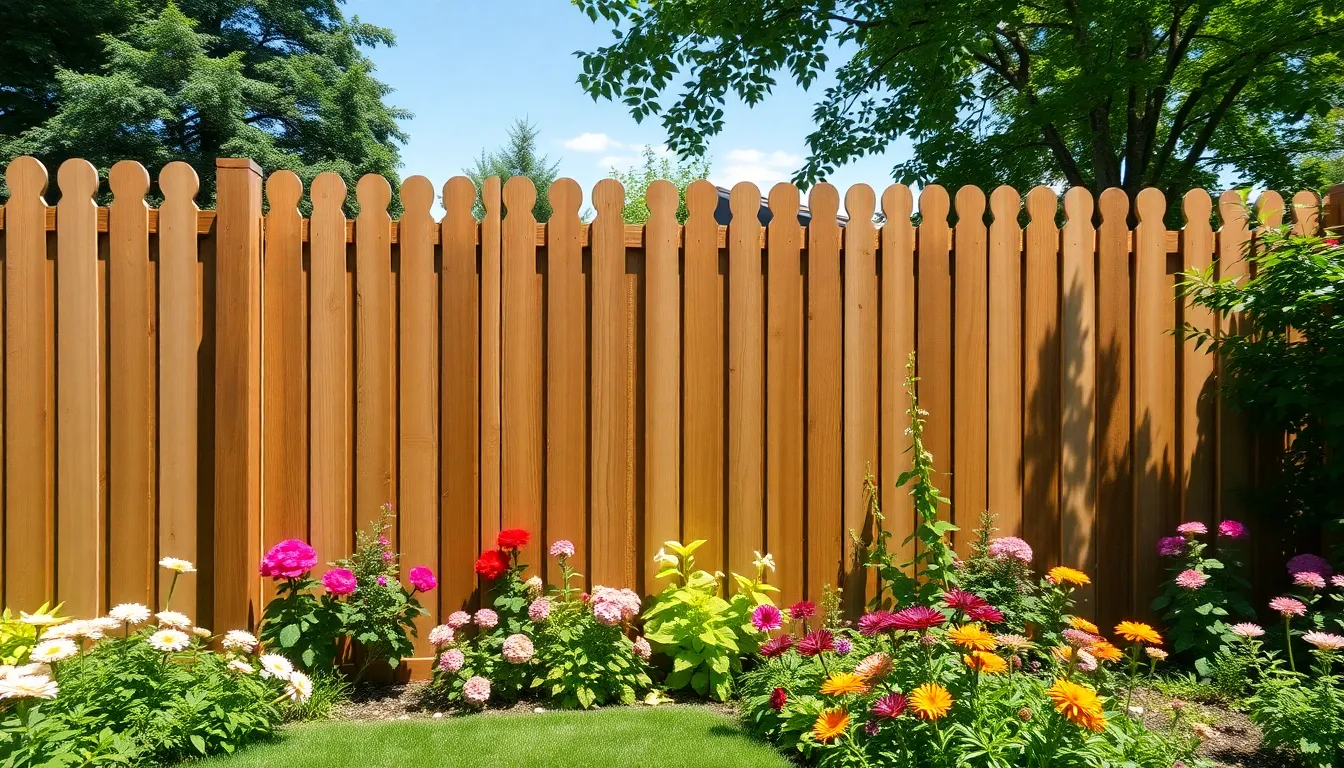
Natural wood stains offer the perfect bridge between classic white fencing and bolder color choices, creating harmony with your garden’s existing industry. These organic tones complement virtually any architectural style while maintaining the authentic beauty of wood grain.
Light Oak and Cedar Tones for Bright Spaces
Light oak stains transform garden fences into warm, welcoming boundaries that enhance sunny outdoor areas. These natural tones create an inviting ambiance that blends seamlessly with greenery, making them ideal choices for bright spaces where you want to maintain an open, airy feeling.
Cedar tones provide slightly more depth than standard oak while preserving the light, natural appearance that works beautifully in well lit gardens. The warm undertones in cedar stains complement both morning sunlight and golden hour lighting, creating a consistently appealing backdrop throughout the day.
Gardens with abundant natural light benefit significantly from these lighter wood tones because they won’t compete with your colorful plantings. Instead, oak and cedar stains serve as neutral canvases that allow your flowers, shrubs, and decorative elements to take center stage.
Dark Walnut and Mahogany for Dramatic Appeal
Dark walnut stains create sophisticated garden boundaries that add instant elegance to outdoor spaces. These rich, deep tones provide dramatic contrast against lighter colored plants and foliage, making your garden’s green elements appear more vibrant and lush.
Mahogany stains offer slightly warmer undertones than walnut while maintaining the same level of visual impact. The reddish brown hues in mahogany create striking backdrops for gardens featuring silver foliage plants, white flowers, or pale colored decorative elements.
Darker wood stains work exceptionally well in larger gardens where you want to create defined zones or intimate seating areas. The deeper tones help establish visual weight and can make sprawling outdoor spaces feel more cohesive and purposefully designed.
Weather-Resistant Stain Options for Longevity
Weather resistant stains protect your garden fence investment while maintaining beautiful color consistency throughout seasonal changes. These specialized formulations penetrate deep into wood fibers, creating barriers against moisture, UV rays, and temperature fluctuations that can cause fading or deterioration.
Semi transparent weather resistant stains allow wood grain to show through while providing excellent protection from the elements. This type of stain typically lasts 3 to 5 years before requiring reapplication, making it a cost effective choice for maintaining your fence’s appearance.
Solid color weather resistant stains offer maximum protection and color retention, completely covering the wood grain while providing up to 7 years of durability. These stains work particularly well for older fences or wood types that have weathering imperfections you’d prefer to conceal.
Bold Black: Modern Garden Fence Color Ideas That Make a Statement
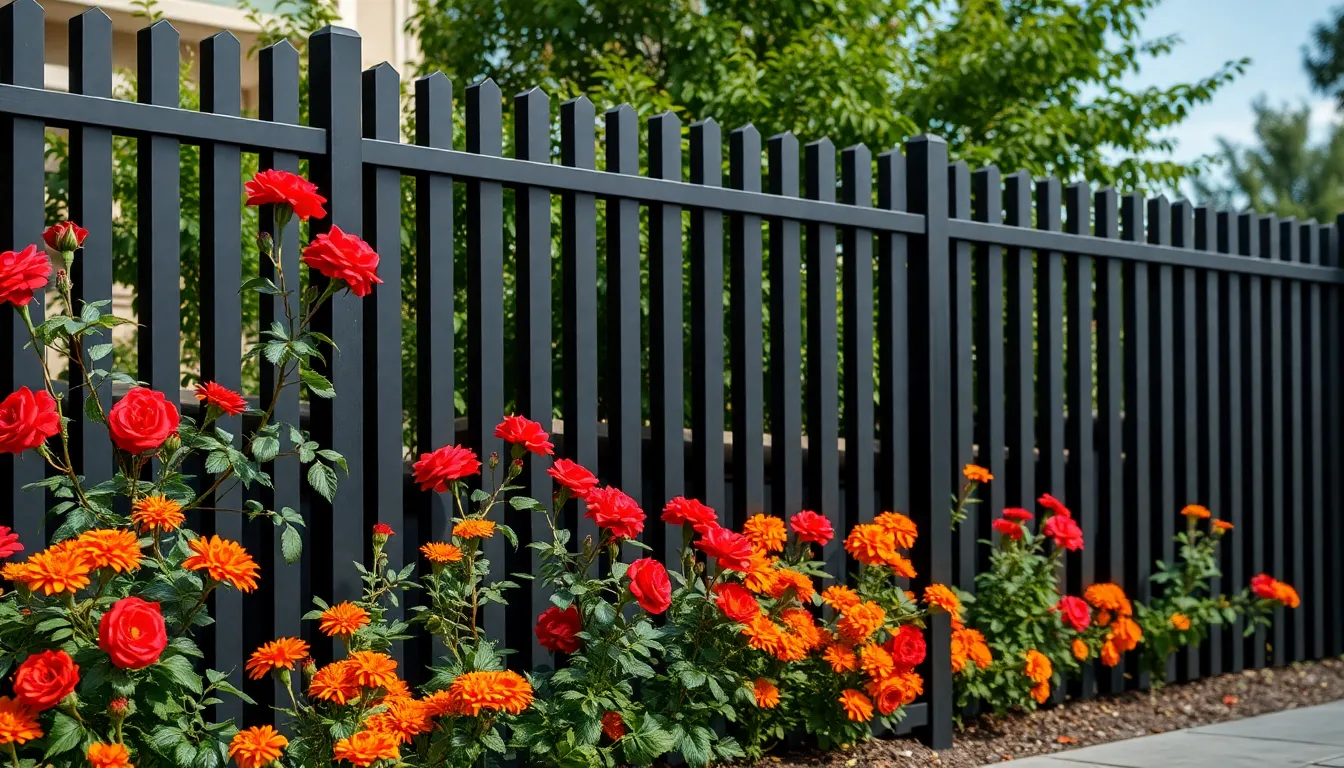
Black fences deliver instant sophistication and serve as the perfect modern backdrop for vibrant garden displays. This bold color choice adds contemporary elegance while creating dramatic visual impact that transforms ordinary outdoor spaces into striking industry features.
Creating Contrast with Colorful Flowering Plants
Vibrant blooms truly shine when planted against black fencing backgrounds. Red roses create stunning contrast combinations that draw the eye and highlight each flower’s natural beauty. Orange marigolds pop dramatically against dark surfaces, making their warm tones appear more saturated and eye-catching.
Strategic plant placement maximizes the visual impact of colorful flowering displays. We recommend grouping bright colored flowers like coral and emerald stone varieties to create bold focal points. Hot pink blooms stand out beautifully against black surfaces, while yellow flowers create cheerful contrast that brightens the entire garden space.
Foliage colors also benefit from black fence backdrops. Green plants appear more lush and vibrant when framed by dark surfaces. Purple flowering plants create sophisticated color combinations that add depth to garden designs.
Maintenance Tips for Black Garden Fencing
Regular cleaning keeps black fences looking sharp and prevents buildup of dirt and debris. We suggest washing the surface monthly with mild soap and water to maintain that crisp, modern appearance. Power washing can remove stubborn stains, but use gentle pressure to avoid damaging the finish.
Protective coatings prevent rust and weather damage that can compromise your fence’s appearance. Apply high-quality exterior paint or sealant every 2-3 years depending on climate conditions. Touch up scratches and chips immediately to prevent moisture penetration and corrosion.
Seasonal maintenance ensures long term durability and visual appeal. Inspect hardware connections regularly and tighten loose fasteners. Remove vegetation that grows too close to the fence to prevent moisture retention and potential damage.
Design Styles That Work Best with Black Fences
Modern minimalist gardens benefit tremendously from black fencing’s sleek, sophisticated backdrop. Clean lines and geometric shapes complement the bold color choice perfectly. Contemporary industry designs use black fences to define spaces without overwhelming plant displays or architectural features.
Rustic chic gardens gain unexpected sophistication when black fencing adds contrast to natural materials. This combination creates interesting visual tension between traditional and modern elements. Formal garden designs achieve dramatic elegance with black boundaries that frame structured plantings and manicured landscapes.
Urban gardens particularly suit black fencing because it complements city architecture and creates intimate outdoor rooms. Industrial style landscapes benefit from the bold, architectural quality that black fencing provides.
Earthy Green Tones: Blending Your Fence Into the Landscape
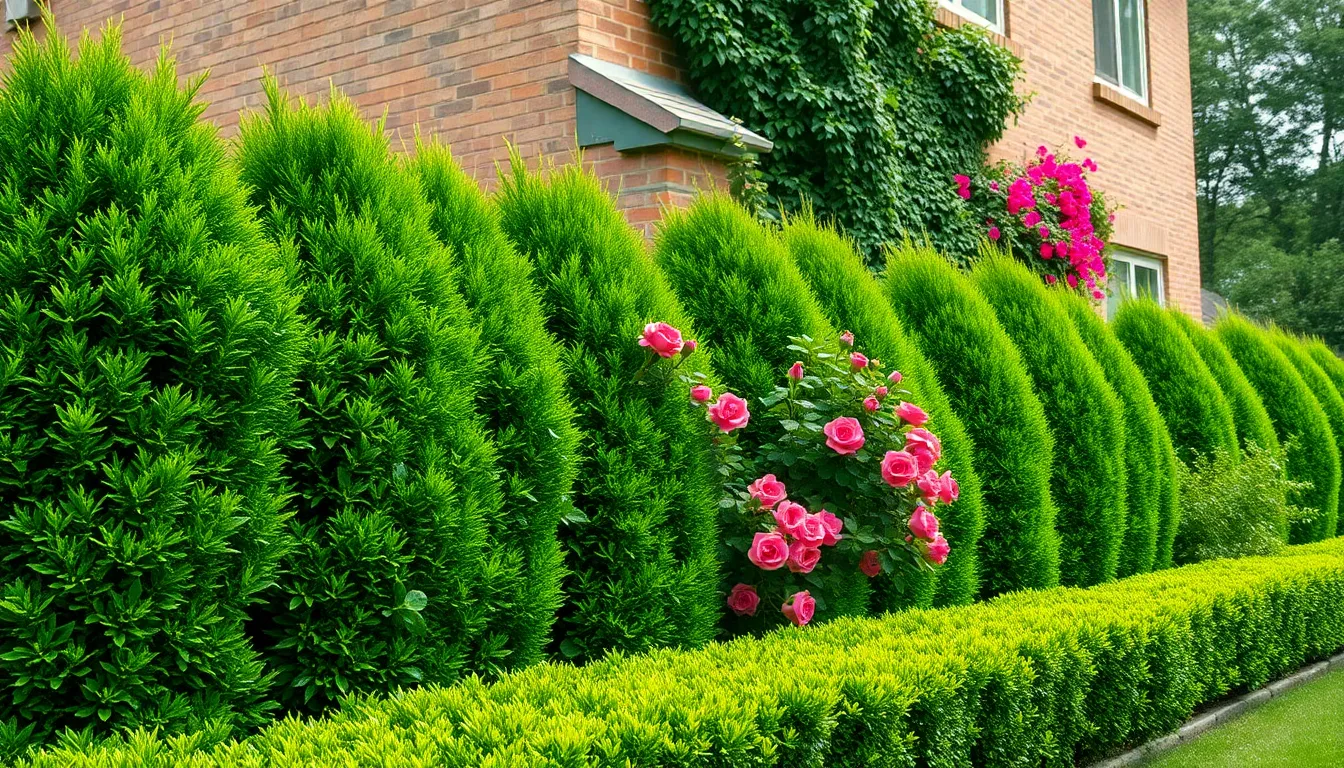
Green fence colors offer the perfect solution for homeowners seeking seamless integration between their garden boundaries and natural surroundings. These earth-inspired hues create visual harmony while maintaining distinct property lines.
Forest Green for Traditional Garden Settings
Forest green delivers timeless elegance for traditional garden designs with its deep, rich character. This classic shade complements lush vegetation naturally while providing enough contrast to define your garden’s boundaries. Traditional landscaping elements like boxwood hedges, climbing roses, and perennial borders appear more vibrant against forest green backdrops.
Homeowners appreciate forest green’s ability to enhance established plantings without competing for attention. The color works exceptionally well with brick homes, stone pathways, and wooden garden structures. Maintenance becomes easier since forest green naturally camouflages minor dirt accumulation and weathering between seasonal cleanings.
Sage Green for Contemporary Outdoor Spaces
Sage green transforms modern gardens with its soft, muted tone that enhances natural beauty without overwhelming the space. Contemporary outdoor designs benefit from this sophisticated color’s ability to bridge architectural elements with organic garden features. Modern plantings like ornamental grasses, succulents, and architectural plants create stunning compositions against sage green surfaces.
This versatile shade pairs beautifully with concrete planters, steel garden sculptures, and minimalist water features. Sage green fencing complements neutral home exteriors while providing subtle definition for outdoor living spaces. The color’s understated elegance supports contemporary design principles that emphasize clean lines and natural materials.
Olive Green for Mediterranean-Style Gardens
Olive green creates harmonious Mediterranean garden atmospheres with its warm, earthy undertones that blend seamlessly with surrounding foliage. This recommended shade adds natural warmth to outdoor spaces while maintaining the authentic feel of Mediterranean design. Drought-resistant plants like lavender, rosemary, and olive trees appear particularly stunning against olive green backgrounds.
Mediterranean gardens benefit from olive green’s ability to enhance terra cotta elements, natural stone features, and rustic wooden accents. The color supports the warm, inviting ambiance characteristic of Mediterranean design while providing practical durability for outdoor conditions. Homeowners find olive green especially effective for creating intimate garden spaces that feel connected to their natural surroundings.
Warm Gray Shades: Sophisticated Garden Fence Color Ideas
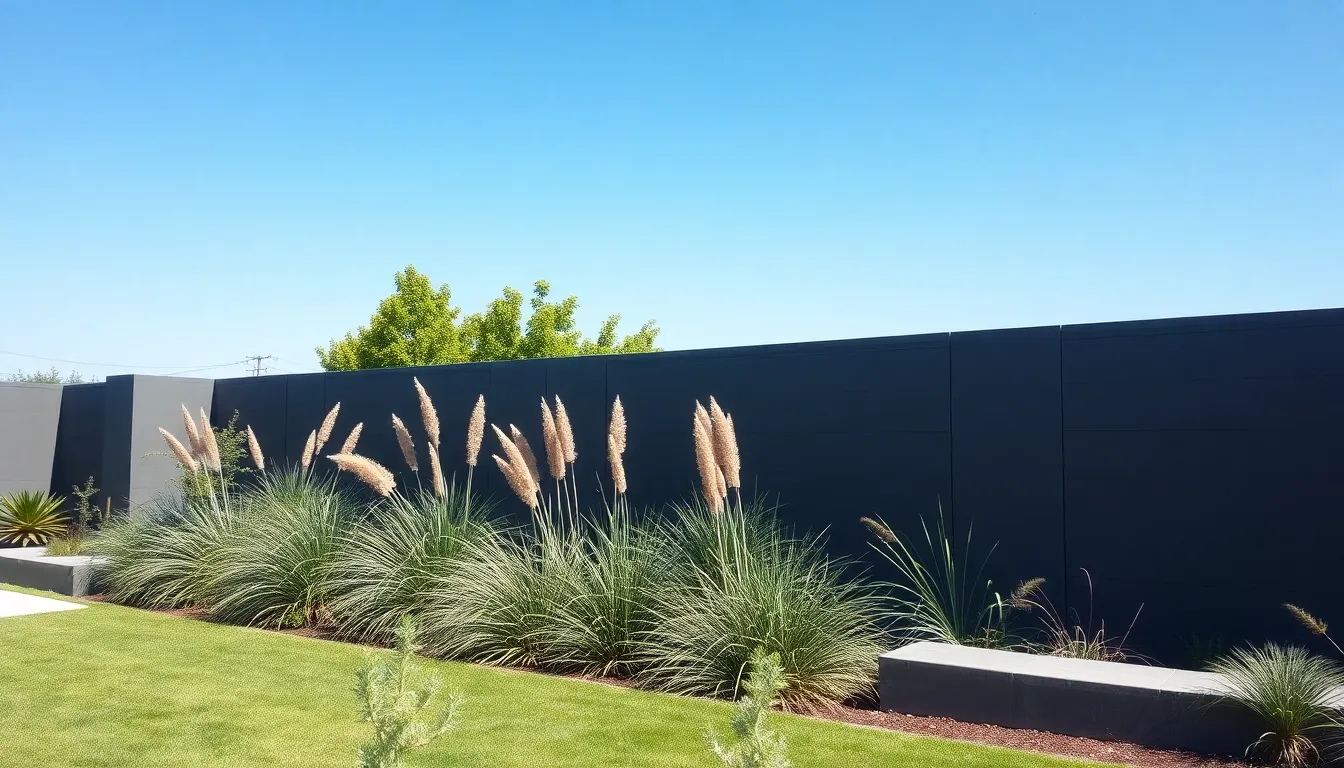
Sophisticated gray tones offer the perfect balance between classic neutrals and contemporary style for garden fencing. These versatile shades complement both traditional and modern home exteriors while creating stunning backdrops for diverse plantings.
Charcoal Gray for Modern Minimalist Gardens
Dark charcoal grays create a dramatic, moody vibe that’s ideal for modern minimalist gardens. This bold color choice visually recedes, making small spaces appear larger while providing a sophisticated contrast to architectural elements. We recommend using charcoal fencing to frame clean lines and geometric plantings in contemporary outdoor designs.
Contemporary gardens benefit from the sleek appearance that dark charcoal provides against modern materials like concrete, steel, and glass. The deep tone enhances the visual impact of ornamental grasses, succulents, and architectural plants with striking forms. Urban landscapes particularly shine when charcoal fencing creates defined boundaries between outdoor living areas and garden zones.
Light Gray for Small Space Illusions
Lighter grays prove useful in small gardens to create the illusion of more space through their ability to reflect natural light. These soft tones blend seamlessly with lighter surroundings, such as sandy colors or light stucco, maintaining visual flow throughout the outdoor area. We find that pale gray fences work exceptionally well in compact courtyards and narrow side yards where maximizing perceived space is crucial.
Small garden designs gain important visual breathing room when light gray fencing serves as an unobtrusive backdrop. The neutral tone allows colorful plantings to take center stage while maintaining clear property boundaries. Cottage gardens and informal planting schemes particularly benefit from this subtle approach to fence coloring.
Blue-Gray Combinations for Coastal Garden Themes
Cool whites with a hint of blue suit properties with Scandi-chic influence, evoking a sense of calm and freshness that mirrors coastal environments. These sophisticated blue-gray combinations create serene outdoor spaces that complement weathered wood, natural stone, and nautical design elements. We’ve observed how these tones enhance the relaxed atmosphere of seaside gardens and lakefront properties.
Coastal garden themes flourish when blue-gray fencing establishes the perfect foundation for salt-tolerant plants and beach-inspired accessories. The color palette naturally complements driftwood accents, sea glass elements, and the silvery foliage of coastal plants like lavender and rosemary. Waterfront properties gain particular appeal when blue-gray fencing harmonizes with natural surroundings while providing necessary privacy screening.
Creative Multi-Color Approaches: Unique Garden Fence Color Ideas
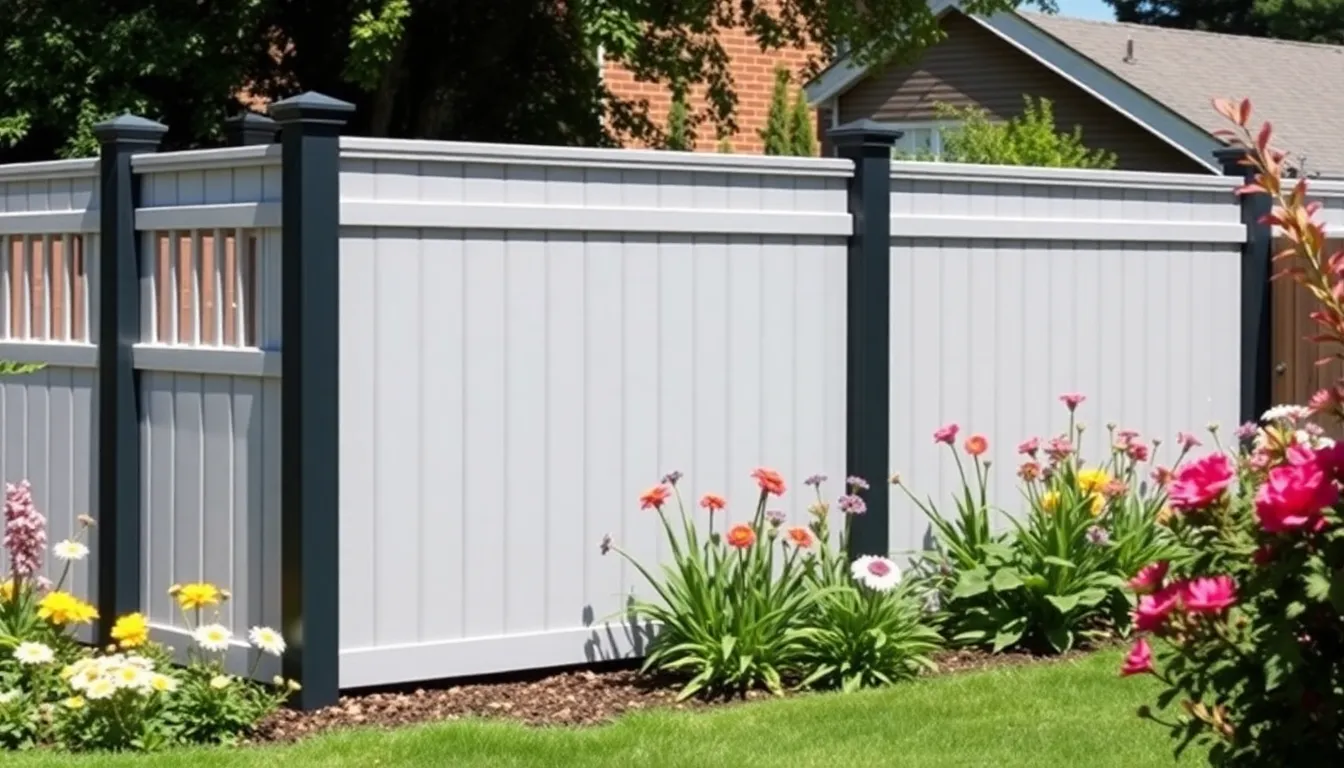
Moving beyond single-color schemes opens up exciting possibilities for creating ever-changing and visually striking garden boundaries. These innovative approaches allow us to express creativity while maintaining the sophisticated appeal that modern homeowners desire.
Two-Tone Fence Designs for Visual Interest
Two-tone fence designs combine different colors for panels and posts to create dimensional visual appeal. We’ve found that contrasting combinations work exceptionally well for establishing focal points throughout garden spaces. Light-colored panels paired with darker posts create sophisticated boundaries that frame outdoor areas beautifully.
Popular two-tone combinations include light gray panels with charcoal posts for contemporary gardens. Natural wood panels with sky blue posts offer a fresh coastal aesthetic that brightens outdoor spaces. We recommend choosing colors that complement your home’s exterior while creating enough contrast to define the fence structure clearly.
Strategic color placement makes the fence architecture more prominent while maintaining visual harmony. Posts in darker shades anchor the design and provide structural emphasis. Panels in lighter tones create breathing room and prevent the fence from overwhelming smaller garden spaces.
Ombre and Gradient Color Techniques
Ombre techniques create flowing color transitions that add artistic flair to garden boundaries. We achieve these effects by gradually shifting from darker colors at the bottom to lighter shades at the top. This approach works particularly well when combined with natural landscaping elements.
Gradient color schemes require careful planning to ensure smooth transitions between shades. Starting with deep charcoal at ground level and transitioning to light gray at the top creates an upward lifting effect. The technique makes fences appear taller while adding sophisticated visual movement to outdoor spaces.
Color blending techniques work best with similar color families to maintain cohesive appearances. We suggest practicing the gradient on sample boards before applying to the entire fence. This ensures consistent color flow and professional-looking results that enhance garden aesthetics.
Accent Panel Ideas with Contrasting Colors
Accent panels transform standard fencing into custom design features by incorporating bold contrasting colors. We select exact panels throughout the fence line to highlight in vibrant shades like red or orange. This creates intentional focal points that draw attention and add personality to garden boundaries.
Strategic panel placement ensures balanced visual weight across the entire fence structure. Choosing every third or fifth panel for accent treatment creates rhythm while avoiding overwhelming patterns. Bold colors like crimson red against neutral backgrounds establish striking garden focal points that complement colorful plantings.
Contrasting accent colors work best when they echo existing garden elements or architectural features. We recommend selecting shades that appear in nearby flower beds or outdoor furniture. This creates visual connections that tie the fence design into the broader industry composition seamlessly.
Seasonal Color Considerations for Your Garden Fence
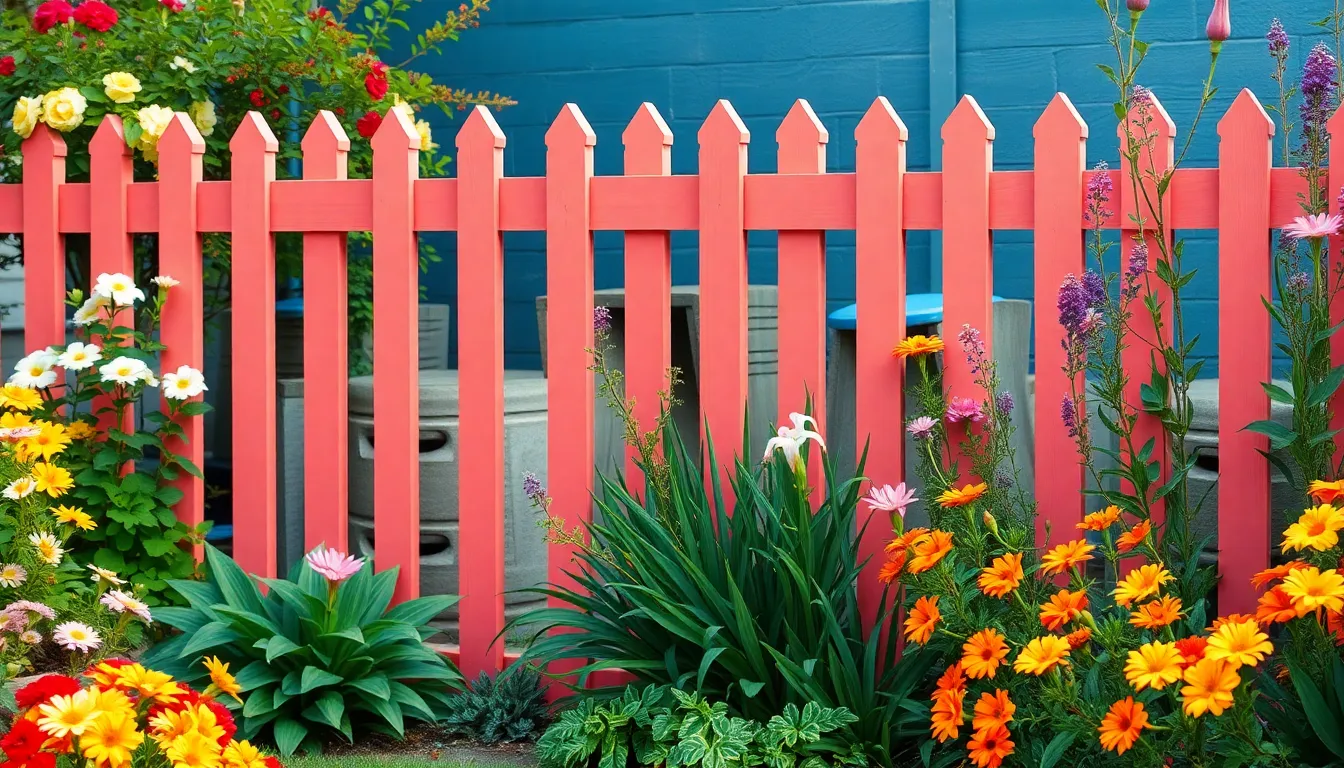
Choosing fence colors becomes more strategic when we consider how they’ll perform throughout the changing seasons. Different times of year call for exact color approaches that maintain visual appeal while working harmoniously with nature’s shifting palette.
Spring and Summer Color Palettes
Bright and vibrant colors transform your garden fence into a stunning focal point during the warmer months. Cuprinol’s Coral Splash delivers that perfect pop of energy, while Frenchic Al Fresco’s Hot Lips creates an uplifting ambiance that complements blooming flowers and lush greenery.
Nature inspired shades work beautifully when you want your fence to harmonize with surrounding foliage. Deep olive tones like Secret Meadow create a welcoming natural backdrop that doesn’t compete with your plantings but instead enhances their beauty.
Vivid color choices during spring and summer take advantage of extended daylight hours and abundant natural light. These seasons offer the perfect opportunity to experiment with bolder hues that might feel overwhelming during darker months.
Fall and Winter Fence Color Maintenance
Neutral and earthy tones become your best allies as temperatures drop and foliage begins to fade. These sophisticated colors maintain visual cohesion when your garden transitions from vibrant summer displays to more subdued autumn landscapes.
Dark neutral selections create the illusion of expanded garden space even when seasonal plants lose their vibrancy. This optical effect becomes particularly valuable during winter months when bare branches and dormant beds might otherwise make your outdoor space feel smaller.
Weatherproof considerations become crucial during harsh winter conditions. Selecting durable paint formulations ensures your fence color investment survives freezing temperatures, moisture, and temperature fluctuations without fading or peeling.
Year-Round Color Stability Tips
Durability stands as the foundation of successful year round fence color performance. Frenchic Al Fresco and similar weatherproof paints maintain their vibrancy through seasonal extremes, protecting your investment while keeping your fence looking fresh.
Neutral backgrounds like slate grey provide timeless appeal that works seamlessly across all seasons. These versatile shades create the illusion of larger garden spaces while serving as perfect canvases for seasonal decorating and plant arrangements.
Regular maintenance inspections ensure your fence remains both secure and visually appealing throughout yearly weather cycles. This proactive approach prevents small issues from becoming costly repairs while maintaining your property’s curb appeal.
Conclusion
We’ve explored a comprehensive range of garden fence color options that can transform your outdoor space from ordinary to extraordinary. Whether you’re drawn to classic white’s timeless appeal natural wood stains’ organic warmth or bold black’s modern sophistication there’s a perfect color solution for every garden style and personal preference.
The key to success lies in understanding how your chosen fence color will interact with your home’s architecture surrounding industry and seasonal plantings. From earthy greens that blend seamlessly into nature to sophisticated grays that add contemporary flair each color option offers unique benefits for improving your property’s curb appeal and value.
Remember that the best fence color is one that reflects your personal style while complementing your garden’s existing elements. With proper preparation quality materials and regular maintenance your newly colored fence will serve as a stunning backdrop for years of outdoor enjoyment.
Frequently Asked Questions
What is the most popular garden fence color choice?
Classic white remains the most popular garden fence color among homeowners due to its timeless versatility and ability to enhance garden aesthetics. White fencing creates visual continuity with home exteriors, reflects sunlight to brighten smaller gardens, and serves as a neutral backdrop that makes colorful plantings pop. It also appeals to a broad range of potential buyers, potentially boosting property value.
Which paint types work best for white outdoor fencing?
The best white paint options for outdoor fencing include acrylic latex, alkyd enamel, and 100% acrylic paints. These formulations offer superior durability against weather conditions, UV resistance, and long-lasting coverage. Acrylic latex provides excellent flexibility and breathability, while alkyd enamel offers a hard, glossy finish. 100% acrylic paints deliver the best overall performance for outdoor applications.
How do natural wood stains compare to painted fence colors?
Natural wood stains create harmony with existing landscapes while maintaining the wood’s natural texture and grain. Light oak and cedar tones work well in bright spaces and complement colorful plantings, while dark walnut and mahogany stains provide dramatic appeal and sophisticated boundaries. Wood stains require weather-resistant formulations, with semi-transparent and solid color options available for different aesthetic preferences.
Can black fencing work in traditional garden settings?
Yes, black fencing can work beautifully in traditional gardens when paired strategically with the right plants and design elements. Black creates stunning contrasts with colorful flowering plants like red roses and orange marigolds, while making green foliage appear more lush. It works particularly well in formal gardens, modern minimalist designs, and urban landscapes when properly maintained.
What are the benefits of using green fence colors?
Green fence colors help blend fencing into the landscape while maintaining distinct property lines. Forest green works excellently in traditional settings and complements brick homes, sage green suits contemporary spaces by bridging architectural and organic elements, and olive green enhances Mediterranean-style gardens. Green tones create visual harmony and support various garden design principles naturally.
How do gray fence colors enhance outdoor spaces?
Gray fence colors offer sophisticated neutrals that balance classic and contemporary styles. Dark charcoal gray creates dramatic effects in modern minimalist gardens, light gray makes small spaces appear larger, and blue-gray combinations work perfectly for coastal themes. Gray tones are versatile and complement various architectural styles while providing elegant backdrops for plantings.
Are multi-color fence designs recommended for gardens?
Multi-color fence designs can be highly effective when executed thoughtfully. Two-tone designs with contrasting panel and post colors create visual interest, while ombre techniques add artistic flair. Accent panels in bold colors can transform standard fencing into custom features. The key is strategic color placement and proper blending techniques to maintain sophistication.
How should fence colors change with seasons?
Fence colors should consider year-round appeal. Bright, vibrant colors work well for spring and summer focal points, while neutral and earthy tones maintain cohesion during fall and winter when foliage fades. Choose durable paint formulations that withstand weather changes, and consider versatile neutral backgrounds that enhance seasonal decorating and plant arrangements throughout the year.


